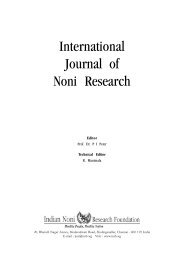International Journal of Noni Research - Noni Family
International Journal of Noni Research - Noni Family
International Journal of Noni Research - Noni Family
Create successful ePaper yourself
Turn your PDF publications into a flip-book with our unique Google optimized e-Paper software.
23 Intl. J. <strong>Noni</strong> Res. 2007, 2(1-2)<br />
P. Rethinam et al. <strong>Noni</strong> (Morinda citrifolia L.) - the Miracle Fruit - a holistic review<br />
anthraquinones (such as nordamnacanthal, morindone, rubiadin, andrubiadin-<br />
1- methyl ether, anthraquinone glycoside), b-sitosterol, carotene, vitamin A,<br />
flavones glycosides linoleic acid, alizarin, amino acids, acubin, L-asperuloside,<br />
caproic acid, caprylic acid, ursolic acid, rutin and a putative proxeronine.<br />
(Levand and Larson, 1979; Farine et al., 1996; Peerzada et al., 1990;<br />
Budhavari et al., 1989; Moorthy and Reddy, 1970; Daulatabad et al., 1989;<br />
Balakrishnan et al., 1961; Legal et al., 1994; Singh and Tiwari, 1976;<br />
Simonsen, 1920; Heinicke, 1985). The dominant substances in the fruit are<br />
fatty acids, while the roots and bark contain anthraquinone. The seed <strong>of</strong> M.<br />
citrifolia contains 16.1% Oil. The main fatty acid components <strong>of</strong> the oil were<br />
linoleic (55%), Oleic (20.5%), Palmitic (12.8%), Ricinoleic (6.8%) and<br />
Stearic (4.9%) (Dualatabad et al., 1989; Seidemann, 2002).<br />
A research group led by Chi-Tang Ho at Rutges University in the USA is<br />
searching for new novel compounds in the <strong>Noni</strong> plant. They have successfully<br />
identified several new flavonol glycosides, and iridoid glycoside from the <strong>Noni</strong><br />
leaves, trisaccharide fatty acid ester, rutin and an asperolosidic acid from the<br />
fruit. Two novel glycosides and a new unusual iridoid named citrifoliniside<br />
have been shown to have inhibiting effect on AP-1 trans activation and cell<br />
transformation in the mouse epidermal JB6 cell lines (Wang et al., 1999;<br />
Sang et al., 2001a and b; Liu et al., 2001; Wang et al., 2000). Further, 23<br />
different phytochemicals were found in <strong>Noni</strong> besides, 5 vitamins and 3<br />
minerals (Duke, 1992).<br />
Biological Properties <strong>of</strong> <strong>Noni</strong><br />
Antimicrobial activity<br />
The anti-microbial effect <strong>of</strong> noni may have been the first observed property:<br />
indeed, the fruit contains relatively large amounts <strong>of</strong> sugars that are not<br />
fermented when fruits are stored in closed containers at ambient temperature.<br />
This property is used to transport the fruit by boat from the scattered Pacific<br />
islands to processing plants without specific treatment. It has been reported<br />
that <strong>Noni</strong> inhibits the growth <strong>of</strong> certain bacteria, such as Staphylococcus<br />
aureus, Pseudomonas aeruginosa, Proteus morgaii, Bacillus subtilis,<br />
Escherichia coli, Helicobacter pylori, Salmonella and Shigella (Atkinson,<br />
1956). The same author claims that the anti-microbial effect observed may<br />
be due to the presence <strong>of</strong> phenolic compounds such as acubin, Lasperuloside,<br />
alizarin, scopoletin and other anthraquinones. Another study<br />
showed that an acetonitrile extract <strong>of</strong> the dried fruit inhibited the growth <strong>of</strong><br />
Pseudomonas aeruginosa, Bacillus subtilis, Escherichia coli, and Streptococcus<br />
pyrogene (Locher et al., 1995). It has also been found that ethanol and<br />
hexane extracts <strong>of</strong> noni have an antitubercular effect since they inhibit by 89-








